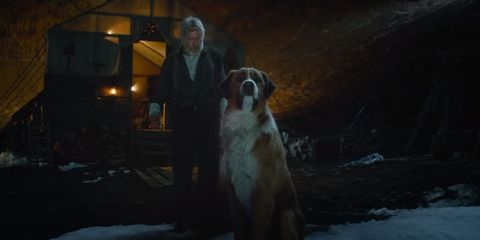Jack London's The Call Of The Wild is more than 100 years old now, and it's one of those books that most probably read in school at some point. But while it's been adapted for the screen multiple times, the last theatrical outing for the story was in 1975, and quite a lot has happened in the film world since then. It seems this is largely the reason that we're getting a new cinematic take on the story today.
The major hook for the new Call Of The Wild, written by Murder On The Orient Express' Michael Green and directed by How to Train Your Dragon's Chris Sanders in his live-action directorial debut, is that Buck, the canine main character of Jack London's novel, is brought to life via digital effects rather than being played by an actual animal. It's a significant gamble, as making your main character CGI and trying to make him look as realistic as possible means the whole enterprise collapses if it doesn't work. Overall, it does work, though. Just enough.
Barely.
As noted, our main character here is Buck. He's a large dog living in Northern California, and the pet of the local judge (Bradley Whitford). He's poorly trained and something of a local terror, but comfortable. However, dogs like Buck can be quite useful in the late 19th century Yukon, where many men attempt desperate search for gold in the mountains. Buck is kidnapped and shipped north. There he ends up the property of a couple running a U.S. Mail route (Omar Sy and Cara Gee), who add Buck to their sled team. He gets a crash course in his new life, but begins to adapt to his new surroundings while discovering something within himself that causes him to wonder if perhaps he wasn't meant to live a domesticated life.
Call Of The Wild’s CGI dog works well enough to get by (most of the time).
While all previous versions of The Call of the Wild have had to use real dogs to tell their story, we're now living in a post-Lion King world, and and Hollywood can create quite realistic animals digitally. Having said that, Call of the Wild's CGI is not on par with the recent Lion King remake on a technical level. There's never a moment in which you might mistake Buck for a real dog, as he always looks slightly off – although, for the most part the CGI is good enough to function. There are a handful of moments where the movie dips a bit into the uncanny valley, such as when Buck is given a moment of unnecessary physical comedy that causes him to move in an unusual way. In those moments, he resembles Scooby Doo. When action is forced to move a little too fast things look more like a video game. It works well enough for the rest of the film, but everybody will react to it a little bit differently.
There are scenes where it's demonstrated that the film isn't just using a CGI dog in a "because we can" manner. Buck experiences a good amount of hardship throughout The Call Of The Wild, and seeing a real animal treated the way he is, even fictionally, probably wouldn't sit well with some audiences. Of course, while Jack London's novel is actually quite violent and bloody, all of that has been toned down for a family friendly PG rating.
Harrison Ford is the main human actor in the film, playing Jack Thornton, a man living on his own in Alaska who crosses paths with Buck a couple of times before the pair become companions. Ford's character doesn't really become part of the movie until the second half, though we still get plenty of Harrison Ford as he acts as the film's narrator as well.
Call of the Wild’s villain is an even bigger cartoon character than the dogs.
While Harrison Ford could likely read the phone book and make it pleasing to listen to, his presence in the first half of the film is simply unnecessary. Ford's narration seems designed to tell us what Buck the dog is thinking, to give us the animals perspective on what he's going through, but for the most part we just end up hearing Harrison Ford telling us exactly what we're already seeing on the screen. Maybe there was a feeling that if The Call of the Wild was paying for Harrison Ford, the production wanted its money's worth, or there was fear that audiences would disengage if there wasn't a line of dialogue on a regular basis during the largely silent dog-driven action, but the movie handles itself perfectly well when only animals are on screen, there's no problem understanding what is going on or what the creatures are feeling.
Having said that, when Harrison Ford does join the movie on a permanent basis the film does improve. It's hard for it not to: this is Harrison Ford after all. Ford is the one who ultimately makes Buck feel the most "real." Most of the latter half of the movie is just Ford and Buck, and the actor makes the interaction between the pair feel seamless.
Harrison Ford's performance looks that much better when compared to the human actors he works opposite. Dan Stevens and Karen Gillan appear as a pair of upper class twits who have come north to strike it rich, but clearly have no clue what they're doing in the wilderness. If they were only there for comic relief, it would be fine, but Stevens becomes the movie's ultimate villain, a change from the novel that was made, almost certainly because Jack London's original ending was very much a product of its time. The character just feels out of place when most everything else in The Call of the Wild tries to play things straight. If this was the remake of an animated Disney movie it might work, but it's not.
Harrison Ford is great, because of course he is.
Most "boy and his dog" stories are ultimately stories about the boy, and while The Call of the Wild does make sure to give Harrison Ford's character an arc too, the film is always about the journey, both physically and emotionally, of the animal. In that regard, Buck does grow and change over the course of the film. Even if you never really think of him as a dog, he's still an endearing enough character, and this is hardly the first time we've been asked to care about an entirely digital protagonist.
Ultimately, whether The Call of the Wild works for you will depend on how much you can empathize with another obviously CGI character. It will require some suspension of disbelief, but if you can do it, then the journey should be worth it.

CinemaBlend’s resident theme park junkie and amateur Disney historian, Dirk began writing for CinemaBlend as a freelancer in 2015 before joining the site full-time in 2018. He has previously held positions as a Staff Writer and Games Editor, but has more recently transformed his true passion into his job as the head of the site's Theme Park section. He has previously done freelance work for various gaming and technology sites. Prior to starting his second career as a writer he worked for 12 years in sales for various companies within the consumer electronics industry. He has a degree in political science from the University of California, Davis. Is an armchair Imagineer, Epcot Stan, Future Club 33 Member.
Most Popular



